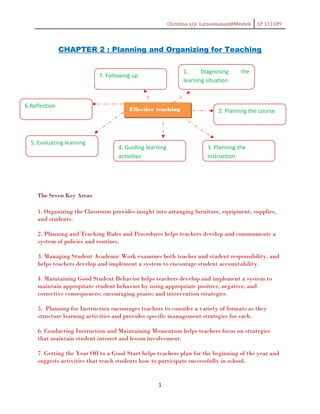
planning & organizing for teaching
- 1. Christina a/p Latsoomanan@Meshek LP 111109 CHAPTER 2 : Planning and Organizing for Teaching 1. Diagnosing the 7. Following up learning situation 6.Reflection Effective teaching 2. Planning the course 5. Evaluating learning 4. Guiding learning 3. Planning the activities instruction The Seven Key Areas 1. Organizing the Classroom provides insight into arranging furniture, equipment, supplies, and students. 2. Planning and Teaching Rules and Procedures helps teachers develop and communicate a system of policies and routines. 3. Managing Student Academic Work examines both teacher and student responsibility, and helps teachers develop and implement a system to encourage student accountability. 4. Maintaining Good Student Behavior helps teachers develop and implement a system to maintain appropriate student behavior by using appropriate positive, negative, and corrective consequences; encouraging praise; and intervention strategies. 5. Planning for Instruction encourages teachers to consider a variety of formats as they structure learning activities and provides specific management strategies for each. 6. Conducting Instruction and Maintaining Momentum helps teachers focus on strategies that maintain student interest and lesson involvement. 7. Getting the Year Off to a Good Start helps teachers plan for the beginning of the year and suggests activities that teach students how to participate successfully in school. 1
- 2. Christina a/p Latsoomanan@Meshek LP 111109 Time in School and Classroom 1. School time is often divided into five distinct categories: mandated time, allocated time, instructional time, engaged time, and academic learning time. The total time available for all activities carried out in a school is established by the state. Typically, elementary and middle schools are in session approximately 7 hours a day for 180 to 190 days. 1. Mandated time : This mandated time must be used for academic, as well as for nonacademic activities. State-mandated time must be divided among the various content areas as well as non-academic activities such as lunch, announcements, recess, and transitions between classes. 2. Allocated time : The time appropriated for each of these activities is often called allocated time. For example, 45 minutes of each day may be used for lunch, and 50 minutes may be needed for changing classes. 3. Instructional time : Teachers must translate the available allocated time into instructional time. Despite their best efforts, however, not all students will stay on task or pay attention all the time. 4. Time on task : Educators refer to another area within instructional time called time on task. 5. Academic learning time : Time on task, or engaged time, differs from mandated, allocated, and instructional times in that it is the actual time individual students engage in learning. They must maximize academic learning time. 1. Mandated time 2.Allocated time 3.Instructional time 4. Time on task 5.Academic learning time 2
- 3. Christina a/p Latsoomanan@Meshek LP 111109 The curriculum The planned and unplanned learning experiences that students undergo while in a school setting. Two types of curriculum: 1. Explicit curriculum refers to what is consciously and intentionally presented. It is the official curriculum, or written curriculum, which gives the basic lesson plan to be followed, including objectives, sequence, and materials, what is taught by the teacher, and the learning outcomes for the student. 2. Implicit curriculum or hidden curriculum includes the norms and values of the surrounding society, the setting in which the learning occurs (including the decoration and set-up of the area), and the broader environment in which education occurs. Curriculum mapping 1. Identify desired learning results for the subject and topics they teach. 3
- 4. Christina a/p Latsoomanan@Meshek LP 111109 • Determine what students should know, understand, and be able to do as a result of the study. • Specify big ideas worthy of understanding. • Delineate enduring understandings on which the teacher and students will focus. • State provocative, essential questions that will guide students' exploration of the big ideas. • Articulate specific knowledge and skill that students will need for effective performance on the goals. 2. Determine acceptable evidence of student learning. • Decide what evidence will indicate that students understand the big ideas. • Consider what performances will indicate that the learners understand and can apply what they have learned, and by what criteria those performances will be judged. • Determine what will constitute evidence of student proficiency with the essential knowledge, understanding, and skill. 3. Plan learning experiences and instruction based on the first two principles. • Decide what essential knowledge, understanding, and skill needs to be taught and coached. • Determine how that should best be taught in light of the content goals. • Plan to ensure that learning is engaging and effective in the context of specified goals and needed evidence. 4
- 5. Christina a/p Latsoomanan@Meshek LP 111109 Curriculum Reform Curriculum Structure The subject-centered curriculum The student-centered curriculum - traditional areas in the traditional disciplines - centered on certain aspects of the learners themselves. - interdisciplinary topics that touch on a wide variety of fields - may explore the learner’s own life or family history or local environment. - on processes such as problem solving - Experiences of the learners become the - on the goal of teaching students to be critical starting point of the curriculum. consumers of information. - Thus the school environment is left open and free. - Learners are made to choose from various activities that the teacher provides. 5
